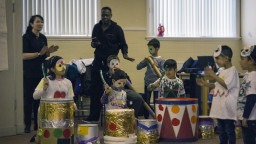E3 There are sufficient materials and equipment to support the activities

It is important that the equipment available is appropriate to the size of the group and the planned activities. For example, if young people are working individually on creating electronic music, there should be enough work stations, software licences and sets of headphones for each of them to have sufficient creative time within the session. Attention to simple detail can change the feeling of the session; if there are not enough copies of the lyrics and young musicians are not able to make their own personal notes on the arrangement, will they remember it as well? Will they develop their own ways to write notes on the music? Will they feel the same sense of ownership and achievement when it goes well?
In this context, ‘materials’ also refers to the session content and the planned activities, and it is important that this has been well prepared by the music leader. In a session observation, in order to see whether this is the case, it may be necessary to talk with the music leader about how and what they had prepared in advance.
Taken from The Garage
Drake Music: Inclusive, properly equipped music sessions often look and sound different to 'normal' music rooms. iPads, BIGmack switches, open tuned guitars, Soundbeams and EyeGaze technology commonly perform together in the same space.
Example: Two music leaders have been invited to set up a Saturday music group in a local concert hall with Disabled and non-disabled young people. In the first few weeks the music leaders bring a wide variety of musical instruments and music tech, to try and ensure everyone can get involved. As they get to know the young people and their support staff better, they learn about how individuals access music in school or communicate more widely. Over time they integrate this equipment and these approaches into the sessions.
